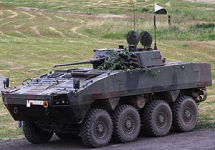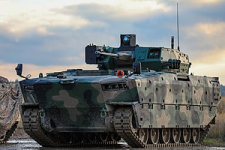The UK is not getting enough bang for its defence buck. Let’s learn from Poland
The Army’s serviceable tanks now number in only the tens. Yet Warsaw is rearming quickly, at lower cost
EDWARD STRINGER22 July 2023 • 8:27pm
The Polish defence minister Mariusz Blaszczak inspects the delivery of the first company of U.S. made Abrams M1A1 tanks last month CREDIT: CEZARY ASZKIELOWICZ/Agencja Wyborcza
Ben Wallace is to bow out, having had a good war. The pivot of that reputation is that he got the big question right: he saw what was unfolding in Russia in 2022 and reinforced Ukraine in a meaningful way.
Not well known is the force of the opposition he overcame from some of our allies – and our own officials – who feared Russian escalation.
It is also true that he made a strong case for defence and got extra funds from a Treasury not minded to be generous. At the same time, he has championed modernisation of the military and been critical of the failings of the Ministry of Defence.
The ability to ride these two positions is probably why Wallace has maintained his status at the pinnacle of ConservativeHome’s table of ministers’ approval ratings: he is an insider/outsider, simultaneously credited with being
decisive on defence while usefully distancing himself from the MoD’s bureaucratic shortcomings. A clever trick, but is it fair given the threadbare state of the UK’s forces?
One can give credit while also asking some difficult questions. Wallace has now been the Secretary of State for four years. Can one continue to point the accusing finger at something you have owned for that long?
The MoD and the three Services continue to grind through ever more money even as the front line shrinks.
The importance of supporting Ukraine has muted any questioning of what that effort has revealed.
It appears that the Army’s front line had serviceable tanks and artillery numbered in the low to medium tens; not the hundreds that the
“fourth largest defence budget in the world” might be assumed to have bought. Who was supposed to be husbanding this equipment? Did the MoD know its parlous state?
In 2019 Wallace is known to have put the new RAF Chief on notice to address as his priority the chronic failings of the Military Flying Training System. When he left four years later they were worse.
Wallace’s Command Paper emphasises a persistent presence overseas. Yet the RAF has prematurely scrapped its most useful air-lifter – the Hercules – as deleting a whole fleet reduces support costs.
The Royal Navy had declared plans to put more frigates to sea in future. It had been “radical” in its reforms of Navy HQ.
But it has run out of money for the ship refits, and the fleet has had to shrink further to afford the plan.
Despite all the evidence from arming Ukraine about the need for weapons stockpiles,
it has taken 17 months to place a contract for more ammunition. Logistics and supportability concerns remain across the board –
we operate very small fleets of expensive, bespoke kit. None of this has been lost on our allies, who raise eyebrows in our direction.
As both the Sheldon report into the Ajax fighting vehicle programme and the House of Commons defence committee’s report into acquisition demonstrate,
an unreformed MoD exhibits labyrinthine, unaccountable processes that overcomplicate and extend programmes at hideous expense.
The game for funds played between the Services causes many delays and itself consumes much of the money. In contrast
, the Polish buy of an extra 980 tanks should complete within four years, in 2026, or just before we take delivery of the first of only 148 tanks. This is after a programme that will have taken between 16 and 25 years – it is hard to be definite given the continual programmatic rejuggling.
Nor are the new forms of warfare we are now seeing in Ukraine news. The MoD’s own think-tanks were forecasting such advances in integrated warfare – via drones and automation, cyber, data and cloud-based computing – since
before Wallace took over. But
it is not in the interests of any Service to volunteer to lead the changes necessary to achieve the integrated force that our emerging doctrine calls for.
We have sat on imaginative blueprints for three years; the
Ukrainians have radically reformed in one.
The UK’s intelligence agencies are racing forward with the digital possibilities that moving to cloud-based computing confers. Defence Digital, a punchy rebrand of what was previously the
MoD’s Information Systems & Services, continues to punch below its weight.
There are legitimate
questions over what the Army is for in the current epoch, and so
how it should be configured to fight a modern war. It is understood that
the Army still hasn’t furnished a compelling vision in answer –
which is one reason it has not made the case for being bigger. And the
Treasury can point to the Poles and credibly ask
why we struggle to get a single division from 70,000 troops when they get four from the same number, and from
an overall budget 40 per cent of our own.
Wallace’s MoD appears to have accepted without question that a properly equipped unit of force will always cost a certain amount, and so the only way to get more force is to demand a bigger budget, or cut the number of units. Hence his
comment about not building a bigger army only to arm it with “pitchforks”. We could, instead, ask
why our allies appear to get more bang for their buck.
So the question that arises from last week’s refreshed Command Paper is not necessarily related to the detail therein. It might be to ask whether Wallace has found it easier to challenge the
MoD as a semi-outsider rather than grip it firmly and force the
level of painful reform it so badly needs.
Whoever his successor is can build on the positives of Wallace’s reign, but there are
some fundamental problems that have hardly been touched at all.
Air Marshal Edward Stringer is a former director general of the Defence Academy and a senior fellow at Policy Exchange







